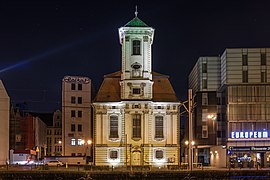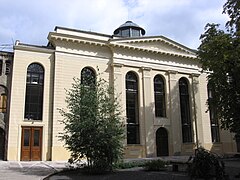Four Denominations District


The Four Denominations District is an area of the Old Town in Wrocław, Poland, between Kazimierza Wielkiego, Sw. Antoniego, Pawła Włodkowica and Sw. Mikolaja streets.[1][2] The name has been used since 1995 on the initiative of Christian clergy (Catholic, Orthodox, and Protestant) and the activist of the Jewish community Jerzy Kichler.

The area was never and is not currently a district in the legal sense.
Sights and culture[]
In this area, there are four temples of different denominations in close proximity.[3][4] These are:
- Orthodox Cathedral of the Nativity of the Most Holy Mother of God
- Roman Catholic Church of St. Anthony of Padua
- Evangelical-Augsburg Church of Divine Providence
- White Stork Synagogue

Orthodox church

Protestant church

Catholic church

Synagogue
The faithful of four denominations organize common charity events, educational meetings for children, and ecumenical prayers to bring closer the cultural and religious diversity of the city. It is one of the city's tourist attractions.[5][6][7]
Other notable places in the neighborhood include the Cristal Planet sculpture, open-air gallery of neon signs, New Horizons movie theater (Wratislavia Tower), the Royal Palace near the Protestant church, Wroclaw Jewish Community building, Small Synagogue, and historical passages.[8][9][10][11][12] The area is also one of the spaces of BWA Wrocław Gallery, the location of Galeria ArtBrut, TYC ART Gallery, GG Gallery & Atelier, Surowiec Club, TIFF Festival, and many other events.[13][14][15]
In order to emphasize the uniqueness of this area, the Wrocław Development Office came up with an idea to develop it and to create a cultural path of four temples, which will connect all the temples and will become the main element identifying this part of the Old Town.[16][17]
See also[]
References[]
- ^ "Dzielnica – Fundacja Dzielnica Wzajemnego Szacunku 4 Wyznań". www.fundacja4wyznan.pl. Retrieved 2021-03-23.
- ^ "The Four Denominations District". VisitWroclaw.eu. Retrieved 2021-03-23.
- ^ Bogdanova, Olga; Makarychev, Andrey (2019-10-01). Baltic-Black Sea Regionalisms: Patchworks and Networks at Europe's Eastern Margins. Springer Nature. ISBN 978-3-030-24878-9.
- ^ Fellerer, Jan; Pyrah, Robert (2020-10-10). Lviv – Wrocław, Cities in Parallel?: Myth, Memory and Migration, c. 1890–Present. Central European University Press. ISBN 978-963-386-324-4.
- ^ "TOP 10: Attractions in Wrocław". VisitWroclaw.eu. Retrieved 2021-03-23.
- ^ Feldman, Max. "Letter from Wrocław: heartland of Poland's hipster revolution". The Calvert Journal. Retrieved 2021-03-23.
- ^ "Wroclaw is this year's European Capital of Culture". The Independent. 2016-01-17. Retrieved 2021-03-23.
- ^ "Cinema New Horizons Wrocław". VisitWroclaw.eu. Retrieved 2021-03-23.
- ^ "Neon Side Gallery". VisitWroclaw.eu. Retrieved 2021-03-23.
- ^ "Cristal Planet". VisitWroclaw.eu. Retrieved 2021-03-23.
- ^ "Gmina Żydowska we Wrocławiu | Wirtualny Sztetl". sztetl.org.pl. Retrieved 2021-03-23.
- ^ "Mała Synagoga we Wrocławiu (ul. Włodkowica 7) | Wirtualny Sztetl". sztetl.org.pl. Retrieved 2021-03-23.
- ^ "Studio gallery". bwa.wroc.pl. Retrieved 2021-03-23.
- ^ "TIFF Festival // Procesy – 2.09–30.09.2020". tiff.wroc.pl (in Polish). Retrieved 2021-03-23.
- ^ "Ruska 46". Retrieved 2021-03-23.
- ^ "Ścieżka Kulturowa « Centrum Informacji Turystycznej i Rowerowej w Dzielnicy Czterech Wyznań" (in Polish). Retrieved 2021-03-23.
- ^ "Dzielnica Czterech Wyznań | Dolny Śląsk". Retrieved 2021-03-23.
- Districts of Wrocław
- Culture in Wrocław
- Religion in Wrocław
- Judaism in Poland
- Arts districts





